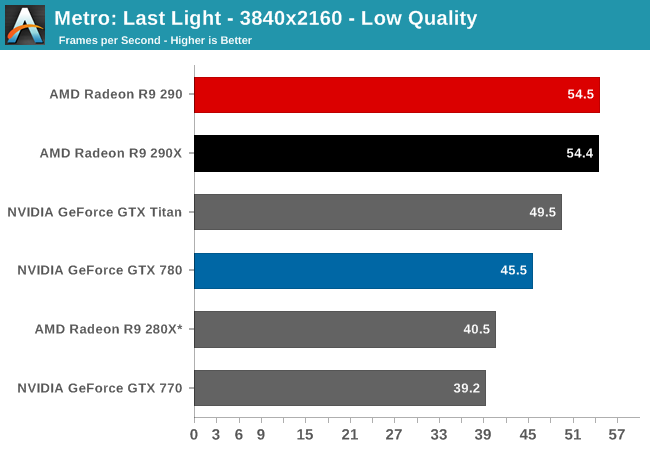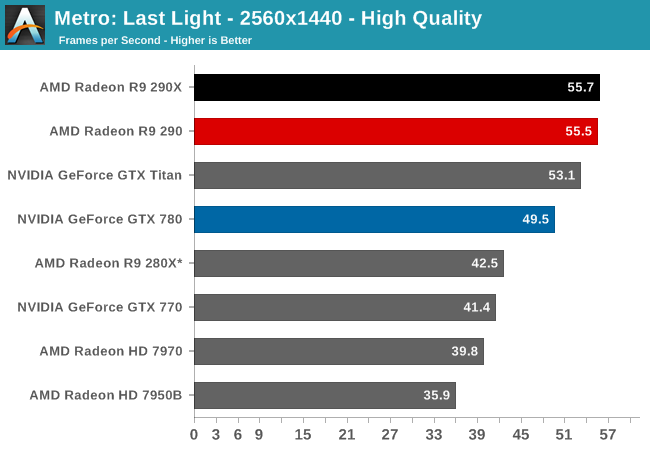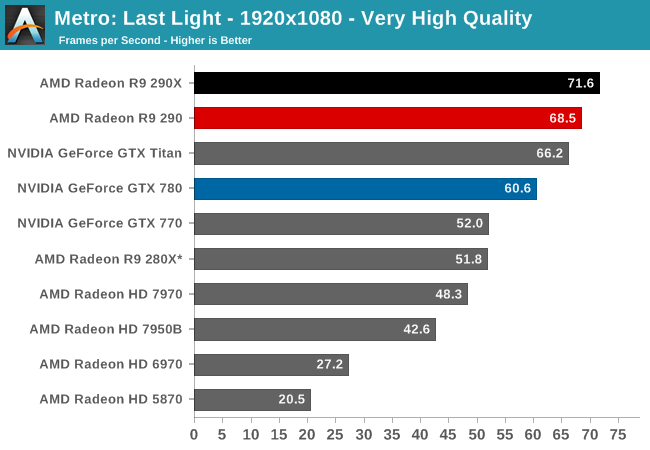The AMD Radeon R9 290 Review
by Ryan Smith on November 5, 2013 12:01 AM EST- Posted in
- GPUs
- AMD
- Radeon
- Hawaii
- Radeon 200
Metro: Last Light
As always, kicking off our look at performance is 4A Games’ latest entry in their Metro series of subterranean shooters, Metro: Last Light. The original Metro: 2033 was a graphically punishing game for its time and Metro: Last Light is in its own right too. On the other hand it scales well with resolution and quality settings, so it’s still playable on lower end hardware.



For the bulk of our analysis we’re going to be focusing on our 2560x1440 results, as monitors at this resolution will be what we expect the 290 to be primarily used with. A single 290 may have the horsepower to drive 4K in at least some situations, but given the current costs of 4K monitors that’s going to be a much different usage scenario. The significant quality tradeoff for making 4K playable on a single card means that it makes far more sense to double up on GPUs, given the fact that even a pair of 290Xs would still be a fraction of the cost of a 4K, 60Hz monitor.
With that said, there are a couple of things that should be immediately obvious when looking at the performance of the 290.
- It’s incredibly fast for the price.
- Its performance is at times extremely close to the 290X
To get right to the point, because of AMD’s fan speed modification the 290 doesn’t throttle in any of our games, not even Metro or Crysis 3. The 290X in comparison sees significant throttling in both of those games, and as a result once fully warmed up the 290X is operating at clockspeeds well below its 1000MHz boost clock, or even the 290’s 947MHz boost clock. As a result rather than having a 5% clockspeed deficit as the official specs for these cards would indicate, the 290 for all intents and purposes clocks higher than the 290X. Which means that its clockspeed advantage is now offsetting the loss of shader/texturing performance due to the CU reduction, while providing a clockspeed greater than the 290X for the equally configured front-end and back-end. In practice this means that 290 has over 100% of 290X’s ROP/geometry performance, 100% of the memory bandwidth, and at least 91% of the shading performance.
So in games where we’re not significantly shader bound, and Metro at 2560 appears to be one such case, the 290 can trade blows with the 290X despite its inherent disadvantage. Now as we’ll see this is not going to be the case in every game, as not every game GPU bound in the same manner and not every game throttles on the 290X by the same degree, but it sets up a very interesting performance scenario. By pushing the 290 this hard, and by throwing any noise considerations out the window, AMD has created a card that can not only threaten the GTX 780, but can threaten the 290X too. As we’ll see by the end of our benchmarks, the 290 is only going to trail the 290X by an average of 3% at 2560x1440.
Anyhow, looking at Metro it’s a very strong start for the 290. At 55.5fps it’s essentially tied with the 290X and 12% ahead of the GTX 780. Or to make a comparison against the cards it’s actually priced closer to, the 290 is 34% faster than the GTX 770 and 31% faster than the 280X. AMD’s performance advantage will come crashing down once we revisit the power and noise aspects of the card, but looking at raw performance it’s going to look very good for the 290.










295 Comments
View All Comments
DMCalloway - Tuesday, November 5, 2013 - link
I agree. My major concern at this point isn't noise or that custom coolers will not be able to dissipate given thermals, but 95*C is a LOT of heat to dissipate into the case. Usually custom coolers are open. It's going to be like running a serious hair dryer in the case.looncraz - Tuesday, November 5, 2013 - link
The 95C figure doesn't matter, only the TDP. This card is by no means in new territory - just in new territory for a stock AMD card with this cooler. A better cooler will still run at 95c if that is the driver and fan speed target, so you will have to rely on the quieter, better, coolers AND custom fan profiles or CCC lower target temperatures. Set the target temperature too low for the cooler and the speed will throttle... so performance will be directly related to the quality of the cooling - which really makes me wonder why AMD didn't consider upgrading their cooler... just looking at their design I can see several ways to improve it for virtually no R&D and very little extra manufacturing cost... a card that has to throttle at stock is a card that needed a little more love before release.DMCalloway - Wednesday, November 6, 2013 - link
Yeah, I get that part. It's still a chip running at higher temps. while drawing at least 50 more watts of juice. Of course the chip will run fine at 95*C+ temps, my concern is with an open heat sink the amount of thermal energy being dissipated into the case is going to be higher. Better coolers more effectively cool the chip, irrelevant for case temps.jjj - Tuesday, November 5, 2013 - link
THG got some retail 290x and they perform a lot worse than the review sample so at this point it seems unclear what the actual perf is for 290 and 290x. You guys need to check if AMD cherry picked the review samples,sending cards that clock well and they sell far slower cards.HisDivineOrder - Tuesday, November 5, 2013 - link
I'd love it if they'd start testing these cards in some cases. Testing them on open air benches is the best way to ignore the obvious heat that's going to build up in a case that's got one, let alone two of these boards, using passive heat loss to help them.Boards this hot running continuously need to be in a case to test for how long it can maintain its boost.
Ryan Smith - Tuesday, November 5, 2013 - link
We do test in a case. All of our tests take place in a NZXT Phantom 630 WE.techkitsune - Tuesday, November 5, 2013 - link
"All of our tests take place in a NZXT Phantom 630 WE."That's about as acoustically horrible as the old black and purple SGI Irix cases. No wonder you registered such a high noise level.
Nikhilanand - Tuesday, November 5, 2013 - link
R9 290 is a performance beast for its price. Almost nearing its big brother R9 290x. Nvidia's latest price cut won't help GTX 780's further sales now. But AMD's partners need to make this one cooler and quieter.woolfe9998 - Tuesday, November 5, 2013 - link
I never comment on reviews, but I was taken aback by the reviewer's final comments. Presuming on behalf of every enthusiast that the noise generated by this card makes it unacceptable even with such a strong price/performance ratio is odd. Everyone has a different noise tolerance. Judging from the comments, most of us are excited about this card, in spite of the reviewer's final remarks which seem to suggest the card's status as a bad product as objective fact when actually the issue of noise tolerance is subjective. The reviewer doesn't seem to understand that even if the noise level actually IS unacceptable, we're not stuck with the reference cooler for very long. Better coolers will come quickly. What a strange review.techkitsune - Tuesday, November 5, 2013 - link
Some of us won't wait for the aftermarket cooler if we want it quiet. We'll rig a water block to it and hook it into the loop. :) Then it will be absolutely silent, the only noise coming from the radiator fans. Three 9,000 RPM Delta fans. ;)